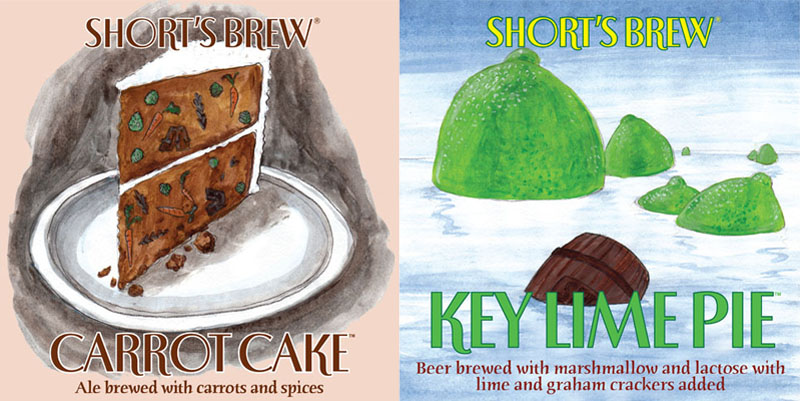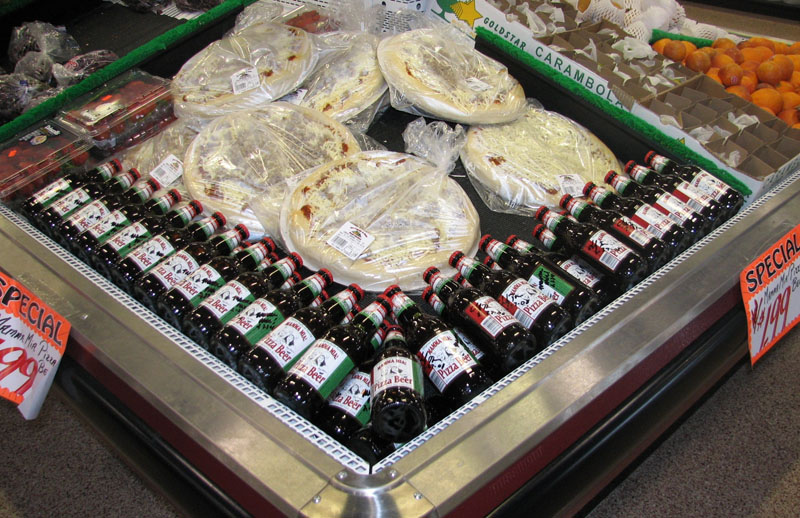Feeding Frenzy: Avoiding Gimmicks in Culinary-Themed Beers
We’ve all seen the T-shirt, Beer Is Food. A growing number of brewers have taken that sentiment to near-literal levels by concocting recipes strongly influenced by culinary creations, be they breakfast, lunch, dinner, dessert or between-meal snacks. Of course, any time a brewery attempts a beer designed to evoke a certain edible, it walks a fine line between flavorful innovation and gimmick.
Tom Seefurth is certainly no stranger to having his creations being labeled the latter ever since he decided to eliminate the middleman in the classic, pre-foodie-movement pairing of beer and pizza. About eight years ago he and his wife, Athena, used whatever pizza-friendly herbs they could harvest from their garden—particularly fresh basil and oregano—along with garlic and, of course, tomatoes.
“Some goes in the mash and some goes into the boil,” Tom Seefurth explains. The result was Mamma Mia! Pizza Beer.
The base is essentially a 4.7% light American ale combining 2-row, Munich and Carapils malts with wheat. It’s very sparingly hopped. “The IBUs are only 11 or 12, so the star of the show is the spices and not the hops,” Seefurth says. “We don’t flavor the beer afterwards. When it’s done, it’s done. And the whole brewery smells like a pizzeria.”
That brewery, from 2008 until recently, was Sprecher, but Seefurth is in the process of transitioning to another contract brewer. Sprecher notified Seefurth last December that it was hitting capacity with its own products and he would have to produce Mamma Mia! elsewhere.
Back when Seefurth first produced Mamma Mia! some of the initial criticism came from his homebrewing peers in the Chicago Beer Society, of which he was an active member.
“It was kind of interesting because a lot of people who were in the beer society saw it as a gimmick,” he says.
He also concedes that the grades on various beer rating sites weren’t exactly stellar once drinkers started trying it.
“It’s like Frank Zappa. Either the drinker really likes it or they hate it,” Seefurth contends. “There’s not someone who says, ‘I kind of like this one.’ It’s either really cool or it’s awful.”
One of the keys to minimizing the number of “awfuls” drinkers hurl at culinary-inspired beer is to remember that it is, first and foremost, a beer, and it should still taste as such. That was the guiding principle behind Carton Brewing Co.’s summer release Panzanella, another beer designed to echo tomato-forward Italian food. In this case its source of inspiration was the salad of the same name, popular in Tuscany, where Augie Carton and his wife spent their honeymoon. Like most classic Italian fare, the Tuscan summer salad is the result of the symphonic arrangement of a few simple ingredients: day-old bread, tomatoes, cucumbers, onions, salt and (sometimes) garlic. To emulate that, the Atlantic Highlands, NJ, brewer started off with a bready 3.8% base and then dressed it up a bit. “We had a really crackery malt bill, then added some Summit hops, which already taste like onions and garlic,” Carton says.
Next up: peeled cucumbers. “We didn’t want to taste cucumber skins,” he explains. The brewery used dehydrated tomatoes, mainly to avoid adding more water, and rounded out the recipe with salt. “It needs salt to make sense,” Carton says.
The project succeeded in its mission, he says, because it was greater than the sum of its parts. It simply reminded drinkers of a salad while remaining a refreshing summer beer.
“The people who didn’t get it wanted it to taste like tomatoes or cucumbers,” he says. “They didn’t get that it’s supposed to taste like a salad, not a tomato.”
Some even swore that they were tasting celery even though there wasn’t any in the recipe. That was the result of the interplay between the cucumbers and hops, which brought a bitter dimension to the former reminiscent of celery’s slight bitterness.
Savory-themed beers are difficult enough to pull off, but when it comes to beers based on certain confectionery products, the challenge is usually twofold. First, there’s the usual danger of heading down the gimmicky rabbit hole. And on top of that is the potentially perilous journey into cloy-ville. On paper, it would seem that the 2012 Cigar City-Funky Buddha-Bluejacket collaboration Snack Attack was headed for that destination: an imperial porter with dry-roasted peanuts, sea salt, cocoa nibs and lactose designed to evoke the types of overpriced indulgences one might buy at a movie theater. But the brewers were very cognizant of the pitfalls inherent in such a candy-coated undertaking and did their best to avoid them for this very-limited release (it debuted to much fanfare during the week of Savor 2012 at Washington D.C.’s ChurchKey). One of the tricks, remembers then-Bluejacket brewer Megan Parisi (now head brewer at Worm-town in Worcester, MA), is to derive much of the desired flavor from the malt and peanuts and not from flavorings. “When you’re working with people on a collaboration, you’ve really got to be sure that you’ve got a good working knowledge of the ingredients,” advises Parisi. “It was good to be working with people with that expertise. It made it easier.”
They were going for what she describes as a “chocolate-covered raisin/chocolate- covered peanut confection” kind of flavor (think Raisinets and Goobers). To achieve that, the team used, in addition to chocolate and caramel malts, Special B, a malt known to exhibit raisin/dried fruit characteristics.
Fruity confections also have been the domain of Short’s Brewing Co., particularly its Key Lime Pie release, which incorporates fresh key limes complemented with a small amount of fruity hops. The sweetness from marshmallows and milk sugar is amped up with large amounts of specialty malts. It even has some graham cracker crumbs combined with toasty malts to simulate the crust flavor.
 Short’s gets even more experimental with its Carrot Cake offering, which, says Short’s head brewer Tony Hansen, includes more ingredients than any other beer in the Bell-aire, MI, brewery’s portfolio: carrot, walnuts, pecans, orange zest, marshmallow, maple syrup, vanilla, nutmeg, ginger and allspice.
Short’s gets even more experimental with its Carrot Cake offering, which, says Short’s head brewer Tony Hansen, includes more ingredients than any other beer in the Bell-aire, MI, brewery’s portfolio: carrot, walnuts, pecans, orange zest, marshmallow, maple syrup, vanilla, nutmeg, ginger and allspice.
It’s no surprise that Hansen is a former cook.
“Keeping the flavors from becoming overly sweet can be tricky when brewing a dessert-inspired beer,” says Hansen. “Finding a balance between the sweet dessert flavor and the drinkable beer can be achieved by the correct usage of traditional brewing ingredients.” A healthy bittering hop addition, he notes, or a yeast strain that finishes dry can help balance the sweetness, as can boosting the ABV.
GABF attendees seem to flock to the Short’s booth when any of these are being poured. And they tend to kick before the Saturday afternoon session. While some may cry “gimmick,” Key Lime Pie actually has two GABF gold medals that argue otherwise. “If a beer doesn’t meet our standards, it will never be served, no matter how much attention it could potentially gain,” Hansen says. “We don’t hesitate to dump a bad brew, learn from our mistakes and try to brew it again until we nail it.”
And nailing it is never an easy thing to do for any brewer. A food is a popular and fairly obvious inspiration for beer; there are exponentially more attempts than there are successes out on the market.
“Everyone really tries to do well,” says Parisi, “but it’s not that easy. But it’s fun to try.”
This story appears in the January 2015 issue of All About Beer Magazine. Click here for a free trial of our next issue.


Leave a Reply